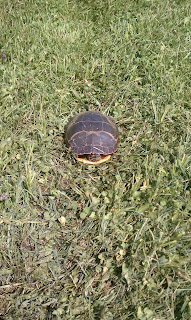It's not every day I get to pick apart a piece of poop, but yesterday proved to be an exception. After a reported sighting of a mother bear and two cubs on the property, Jamie, fellow intern Olivia and I, set out to locate possible "nursury trees," which would be a good location for a wildlife camera. Nursury trees or "baby-sitting trees" are so named because a mother bear likes to find such trees to provide a sort of safe jungle-gym for her cubs, so she can leave them in this kind of sheltered grove while she sees to the business of the day. Nursury trees typically have thick bark and lots of low branches, so little bears can practice their climbing. Jamie had already scouted out an area just north of Cranberry Swamp, which has both lowland and upland habitats, which he thought had some ideal nursury trees. Though we didn't find any sign of the bears amongst the trees, on our way back along Cranberry Swamp Trail, we came across a nice spicemen of bear scat.
![]() |
| Bear Scat with Deer Hoof on Ruler |
The first thing we noticed about this particular spicemen was how hairy it was. Now, I don't mean hairy in the treacherous sense of the word, but hairy as in, bushy, furry, and full of deer fur. Jamie pulled out his tweezers and other poop-examining tools, and extracted a small triangular object. At first glance, it looked like a tooth, but after Jamie explained it was made out of caratin (which is what our nails and hair is made out of), we came to the conclusion it was a claw. More specifically, Jamie clarified, it was a deer hoof. The hoof was hardened on the bottom, which means that it didn't belong to a stillborn fawn, but to a deer who had been up an walking about.
A black bear doesn't exactly have a strong moral conscious, and so wouldn't hestitate to eat a nice little fawn the had been bedded down by its mother. For the first 4 weeks of its life, a baby deer is pretty uncoordinated. The mother will typically create a nice bed for the fawn to stay in until it is strong enough to really move around on its own. What good luck for the bear who happens upon such an easy target! Who knew you could learn so much by just stopping to look at a piece of poop!























